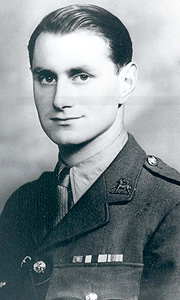Brigadier MEM MacWilliam CBE DSO MC TD
 |
(Click to enlarge) |
Brigadier Maurice MacWilliam had possibly the most remarkable record of the number of young officers of The Queen’s Royal Regiment who achieved great distinction in the 1939-1945 War. He joined the Artist’s Rifles as a Territorial soldier in April 1939, being commissioned in August 1939 – he then rose to commanding his Battalion at the age of 24, was awarded an MC and three DSOs and finally, briefly, was in command of 169 (Queen’s) Brigade in 1946.
Maurice MacWilliam was born on 7th February 1920 and after school at St Pauls was destined for a career in the City. His commission into The Queen’s Royal Regiment took him to the 2/7th Battalion, a doubled-up TA Battalion, which, after training went to France in April 1940 as lines of communication troops. However with the German breakthrough in May the Battalion was soon under attack. MacWilliam’s platoon were in a position covering an important Supply Depot, and he held this position throughout the day before being ordered to withdraw, then leading his platoon back across country for three days before being reunited with the remainder of the Battalion. He was awarded the MC.
The Battalion back in England became part of 169th (Queen’s) Brigade in 56th London Division, and this took them to Iraq in 1942, then to Enfidaville, before the invasion of Italy in September 1943. For this MacWilliam was commanding the left assault Company of the Battalion (and of the Division); his objective inland was strongly defended and three separate attacks were made before the position was taken. Inspite of the loss, killed in action, of two of his platoon commanders MacWilliam’s leadership and gallantry ensured success and he was awarded the DSO. In late October he was wounded and did not rejoin the Battalion until April 1944 in Egypt becoming shortly Second-in-Command.
On return to Italy for the battles to break the Gothic Line the Battalion’s Commanding Officer was wounded almost immediately and MacWilliam found himself in command. Five days later he led the Battalion in the major assault on the ridge of Gemmano. After an intense battle lasting some 15 hours the Battalion achieved its objective of clearing the village of Gemmano. Four days later the Battalion took part in the Army attack from the Coriano Ridge; this involved an assault in conjunction with the 2nd RTR on the Casa Fabbri ridge about one mile forward. Very heavy defensive fire met the attack and within 15 minutes the assault companies were held up, with in one all the officers wounded and in the other two platoon commanders killed. MacWilliam personally reorganized the two companies and brought forward the reserve company, redirecting the line of attack. By these actions he regenerated the assault, and 2nd RTR were able to sweep through the German positions. In the action some 350 German prisoners were taken and at least 50 German dead were counted, but 2/7th Queen’s had suffered nearly 100 casualties, which added to the similar number at Gemmano meant the Battalion was now very weak. The disbandment of one Brigade of 56 Division to an extent remedied the situation with 2/7th Queen’s being reinforced from 7th Ox & Bucks LI, and Maurice MacWilliam led them on to further successes on the flat lands of the Po plain. For his leadership and personal bravery throughout the Gothic Line and especially for the Casa Fabbri victory he was awarded a second DSO. After the Gothic Line MacWilliam reverted to Second-in-Command, but in December he was formally appointed Commanding Officer.
The early months of 1945 were spent in actions to drive the Germans back to the River Senio, and then in April the final Army Group assault was launched. For the Queen’s Brigade of 56 Division his involved an assault across Lake Commachio, then the Argenta Gap, across the River Po and finally the Adige. Throughout MacWilliam led his Battalion with his usual personal gallantry, dash and initiative with at the end the Battalion 15 miles on from the Adige when the Brigade Commander was only expecting patrols to be across the river; he was awarded the second Bar to his DSO.
With the end of the War Maurice MacWilliam was persuaded to apply for a Regular Commission, and he was duly appointed into the Queen’s Royal Regiment in August 1946. However as a War Substantive Major and still only 26 there were problems in placing him and he was never able to serve again as a Regimental Officer in the Regiment. He filled a series of staff appointments, was an instructor at the RMA Sandhurst, on the Directing Staff at the Staff College, and served with the Sudan Defence Force, in 1958 becoming Commander of the Somaliland Scouts. Here his leadership and steadiness over the two year period greatly contributed to the smooth transition of a volatile people to independence.
After a further Staff job in Germany he was then selected to take command of the Federal Regular Army in Aden in April 1964. This was at the time of the Radfan operations, and he found a confused situation. His assessment of this and his demands as to future organization were not accepted by an excitable General. MacWilliam was never one to compromise and he returned home. This was a tragedy for his career and the Army, but he never complained. Instead he went on to command a TA Brigade and then was Chief of Staff in Hong Kong receiving a CBE.
He retired in 1971 living at Dedham and being involved in many local activities. He had married Norah Young, a nursing sister in 1941 having two sons and four daughters – his younger son John became a respected and well liked officer in The Queen’s Regiment before retiring early, and became a Bishop with a large diocese in North Africa..
He died on 30th December 1996.
Related
